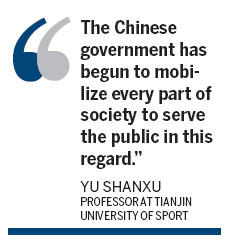Sports
It's all working out for China
By Tang Zhe (China Daily)
Updated: 2012-01-20
Newly-released White Book says the fitness program has been successful
BEIJING - The State General Administration of Sport of China on Tuesday released a White Book to summarize the implementation of the nationwide fitness program from 1995 to 2010.
China unveiled its National Fitness Program Outline in 1995 in a bid to promote greater public participation in sports.
According to the White Book, 28.2 percent of Chinese were regularly exercising by 2007. By 2010, there were 18,000 community fitness clubs and more than 2,200 national physique monitoring stations. Meanwhile, 37,000 schools have opened their sports facilities to the public.
"We have made considerable achievements since the National Fitness Program Outline was issued in 1995, and it has helped to widely improve people's consciousness in building up their bodies and has also strengthened the government's recognition of the health program," said Feng Jianzhong, deputy director of the State General Administration of Sport of China.
"Moreover, we have also made certain accomplishments in venue construction, activity organization, exercise network building, and have substantially expanded the program's influence among the public," Feng said.
The 2008 Beijing Olympic Games played a major role in luring more people into the program. The opening day of the 2008 Games, Aug 8, was set as the country's Fitness Day in 2009.

Yu Shanxu, a professor at the Tianjin University of Sport, who took part in the drafting of the National Fitness Program Outline, said China's determination to promote mass sport follows a worldwide trend to improve physical fitness.
"We collected a lot of material when we started to draw up the outline, and we found there were already dozens of countries using such institutional measures to serve the fitness of their countrymen at a national level in the mid-1990s," Yu said.
"For example, the United States has had a Healthy People program for a long time, Germany launched its Golden Plan to increase fitness venues, and Japan has established Healthy Japan 21."
"People's health should be regarded as an important issue for all countries. The Chinese government has begun to mobilize every part of society to serve the public in this regard," Yu said.
Despite the progress made in recent years, problems remain, the White Book pointed out.
Facilities are still lagging behind the requirements of such a large population and there is considerable discrepancy between the country's developed and under-developed regions in terms of allocated sport resources.
"We are still behind developed countries in the number and percentage of people regularly participating in exercises," said Sheng Zhiguo, director of the Sports for All Department under China's General Administration of Sport.
"Moreover, there are few young and middle-aged employees exercising, as well as teenagers and children, who generally do not exercise and urgently need to improve their fitness."
China Daily
(China Daily 01/20/2012 page22)
